Describe the Most Important Distinction Between High Classical Greek Art and Roman Art
The Greek sculpture, the Spear Bearer Doryphoros is globe-renowned and portrays a well-congenital warrior. The Doryphoros of Polykleitos initially featured a spear, hence the proper name of the Spear Bearer sculpture. The Doryphoros sculpture is a very important instance of Classical Greek realism. Only when was the Spear Bearer created? And why was Doryphoros, or Spear Bearer, famous throughout the aboriginal world? Let the states find out more than.
Table of Contents
- 1 The History of the Spear Bearer Doryphoros
- 1.1 The Conception of the Doryphoros of Polykleitos
- ane.2 Clarification of the Spear Bearer Doryphoros
- i.iii Copies of the Doryphoros Sculpture
- 2 Influence of the Spear Bearer Doryphoros
- 3 Oftentimes Asked Questions
- 3.1 When was the Spear Bearer Created?
- 3.2 Why was Doryphoros, or Spear Bearer, Famous Throughout the Ancient World?
- 3.three Why Is the Doryphoros Sculpture So Important?
- three.4 Who Was Polykleitos?
- 3.5 What Did the Spear Bearer Exemplify?
The History of the Spear Bearer Doryphoros
The missing bronze prototype of the Doryphoros sculpture, portrayed somewhat larger than life-size, would accept been cast around 440 BC, but information technology is currently only recognized from after (more often than not Roman era) marble replicas. Polykleitos, a prominent Greek sculptor, created a sculptural piece as a presentation of his textual treatise that illustrated what he regarded to be the admittedly balanced and harmonious dimensions of the human body in the sculptural form.
The renowned spear bearer sculpture had a significant impact on other ancient fine art forms.
| Engagement of Creation | c. 120 – fifty BCE (replica) c. 440 BCE (original) |
| Location Institute | Pompeii (replica) |
| Artist | Polykleitos (original) |
| Medium | Statuary (original) Marble (replica) |
The Conception of the Doryphoros of Polykleitos
The Greek medical author Galen remarked about the Doryphoros in the 2nd century AD every bit the ideal aesthetic embodiment of the Greeks' yearning for residuum and elegance, which is expressed in the ideally proportionate carved male person nude: Chrysippus believes that beauty consists not in the ratios or commensurability of the component aspects of the body, simply in the paired comparing of the sections, such as that of palm to palm, and of all the digits to the palms and wrists, and those to the forearms, and of the forearms to the upper arms, and, in reality, of all of information technology to everything else, equally written in Polykleitos' Canon.
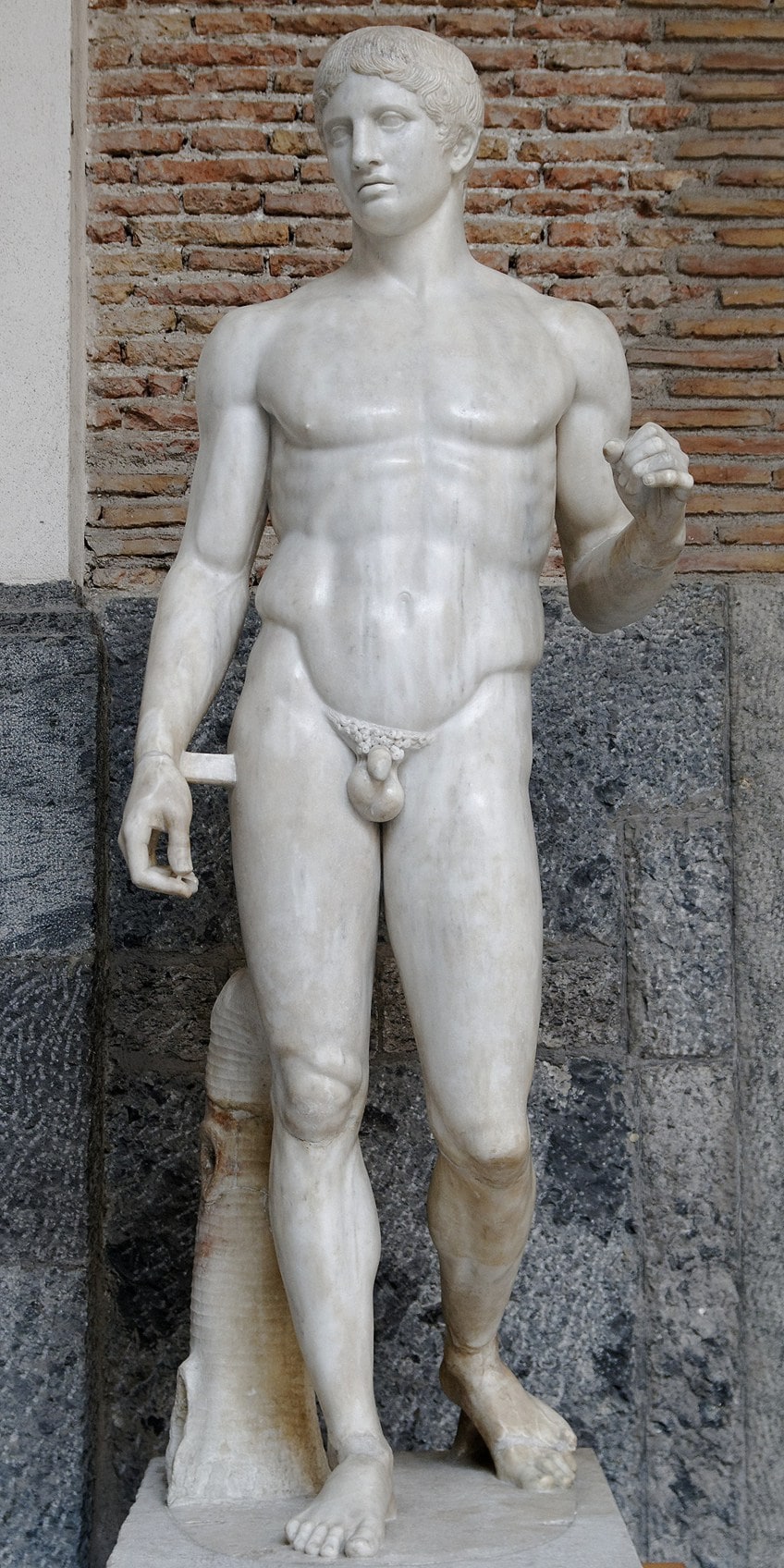 Doryphoros from Pompeii (1st century BC) after Polykleitos;Later Polykleitos, CC By 2.5, via Wikimedia Commons
Doryphoros from Pompeii (1st century BC) after Polykleitos;Later Polykleitos, CC By 2.5, via Wikimedia Commons
Polykleitos is regarded every bit the greatest male sculptor, with his master themes being male sportsmen with perfect torso ratios. He was fascinated by the quantitative dimensions of the physical figure, which drove him to create the Canon, a dissertation on trunk features. The Doryphoros of Polykleitos is an case of his Canon teachings on the harmony of bodily parts. Polykleitos used the chiastic concept to establish an equilibrium between muscle contractions and relaxation.
"Scholars agree that Polykleitos used a single module, perchance the terminal portion of the little finger, to calculate the equivalent measurements of each bodily component."
Description of the Spear Bearer Doryphoros
The Doryphoros sculpture is a marble replica from Pompeii that dates between 120 and fifty BC. The original, constructed of statuary around 440 BC, is now gone. Neither the initial sculpture nor the dissertation has been discovered; it is usually assumed that they did not survive antiquity. Thankfully, many Roman marble replicas of dissimilar quality and wholeness have survived to portray the core shape of Polykleitos' masterpiece. The famous Greek sculpture is around six feet tall.
Polykleitos employed specific ratios to create this piece; for example, the head-to-body ratio is one to seven.
The heavily-muscled but dynamic physique of the Spear Bearer sculpture is represented poised at the moment when he advances frontward from a static stance, with his head tilted slightly to the correct. This stance depicts only the tiniest incipient movement, simply the extremities and trunk are totally responsive. The left hand in one case clutched a lengthy spear; the left shoulder (upon which the weapon formerly lay) is strained and and so somewhat lifted, with the left arm flexed and strained to keep the spear in place.
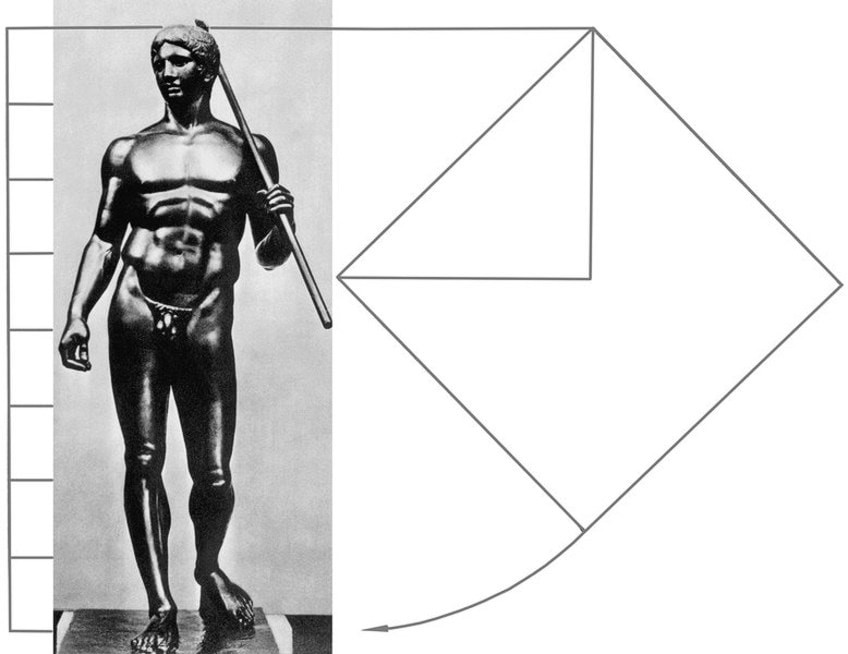 A proportional diagram showing the "square figure" of Doryphoros, reconstruction by V.K. Vlasov, 1989; Polykleitos, Public domain, via Wikimedia Commons
A proportional diagram showing the "square figure" of Doryphoros, reconstruction by V.K. Vlasov, 1989; Polykleitos, Public domain, via Wikimedia Commons
The attitude of the subject is traditional contrapposto, every bit seen past the tilted location of the pelvis. The right leg of the figure is extended, every bit if information technology is sustaining the weight of the upper torso, with the correct hip elevated and the correct torso constricted. The left leg is weightless, and the left hip is lowered, somewhat expanding the body on the left side. The right arm swings at the model's side, conveying no weight. A massive carved tree stump is inserted behind ane leg of the sculpture in the remaining Roman marble replicas to hold the load of the marble; it would not have been there in the initial bronze as the strength of the bronze would have deemed it superfluous.
In most cases, a tiny strut is likewise provided to maintain arm and hand.
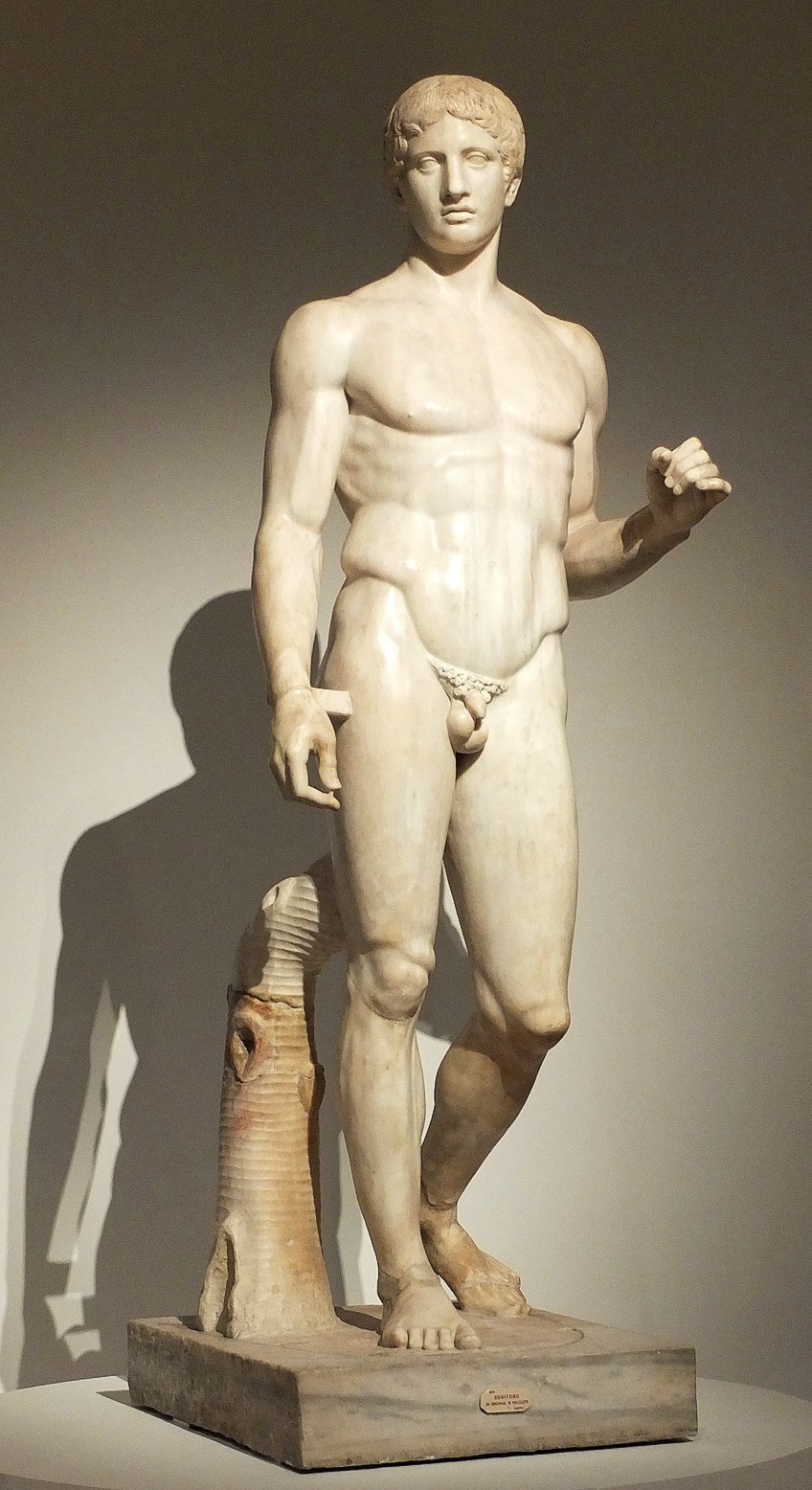 Doryphoros from Pompeii;Naples National Archaeological Museum, CC BY-SA 3.0, via Wikimedia Eatables
Doryphoros from Pompeii;Naples National Archaeological Museum, CC BY-SA 3.0, via Wikimedia Eatables
Even though the Doryphoros sculpture portrays a soldier primed for combat, he is not wearing any armor or other safety habiliment. In truth, if it hadn't been for the 18-carat weapon that the sculpture was property, it might have been hard to recognize him every bit such. Masculine nudity or openness, a characteristic of classical Greek art, was viewed as a symbol of civilization that distinguished the Greeks from their "savage" rivals.
Many of the near of import Greeks of the time, including painters, authors, intellectuals, and statesmen, were concerned with the thought of striving for excellence while acknowledging that such completeness was unachievable.
Doryphoros' face is lacking distinguishing traits, implying that he is supposed to symbolize an idealistic course of the ordinary human, the perfect Greek masculine inhabitant (women somehow were non regarded as citizens). Yet, his physique – proportionate, balanced, nude, powerful, and confident – is ane that the audience may aspire to, but never reach.
Copies of the Doryphoros Sculpture
The marble statue and bronze head discovered at Herculaneum were not recognized as Polykleitos' work until 1863. A partial Doryphoros torso in basalt in the Medici collections at the Uffizi "expresses the appearance of bronze and is done with infrequent care," as Kenneth Clark observed: "It maintains some of the intensity and focus of the predecessor" absent in the full-size "boxy" marble replicas. The all-time-known version of the Doryphoros was discovered in Pompeii and is currently housed in Naples' Museo Nazionale. A bronze herma of Apollonios, housed in the very same museum, is regarded by many experts to exist an near faultless reproduction of the genuine Doryphoros head.
The Minneapolis Institute of Fine art bought a Roman-era indistinguishable of the Greek sculpture in Pentelic marble in 1986, and information technology has received the greatest involvement in subsequent years.
The fine replica, which is mostly complete besides the lesser left arm and digits of the dominant wrist, has been assigned to the era 120 to fifty BC and also the mid-Augustan era. Co-ordinate to the Minneapolis Found of Fine art, the replica was discovered in Italian seas in the 1930s and remained several years in private Italian, and Canadian collectors earlier emerging in the fine art market about 1980. Italy is however claiming the Spear Bearer sculpture's render since it was unlawfully dug and shipped from Stabia.
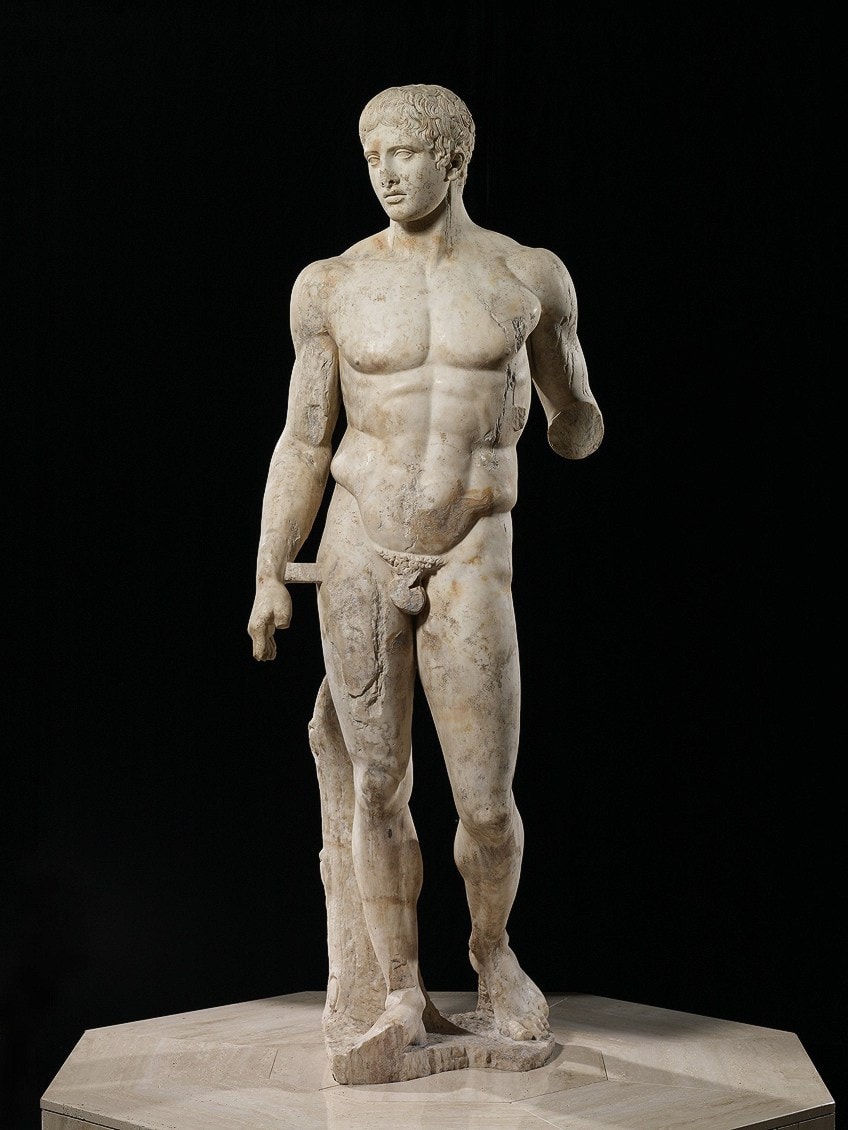 Doryphoros, 120–50 BCE, Minneapolis Establish of Fine art, subsequently Polykleitos;Minneapolis Establish of Art, Public domain, via Wikimedia Eatables
Doryphoros, 120–50 BCE, Minneapolis Establish of Fine art, subsequently Polykleitos;Minneapolis Establish of Art, Public domain, via Wikimedia Eatables
The Minneapolis Institute of Art's Doryphoros of Polykleitos is in excellent shape, specially given its antiquity. Excluding the left arm, all of the fractures in this facsimile are old. The head is still undamaged. There are some significant scrapes on the side, and the markings on his face and artillery are from plant roots, implying that this duplicate has been buried for generations. Information technology was discovered in six parts and has since been rebuilt.
The Doryphoros sculpture has undergone minor repairs, such as "a steel pin placed into the tree torso that supports the right leg, and the artwork has been reconstructed from the six fragments in which information technology was discovered."
Influence of the Spear Bearer Doryphoros
During the high Classical era, the Doryphoros sculpture was invented. During this menses, at that place was a focus on the platonic male, who was shown in purple nudity. The physique would be that of a youthful sportsman, with sculpted muscles and a realistic pose. The expression on the face is emotionless.
Some academics believe the Doryphoros of Polykleitos depicted a youthful Achilles on his style to gainsay in the Trojan War, while others experience the statue is unclear whether it depicts a human or a god.
There were also debates over where these statues may have been establish during the loftier Classical era. For case, the duplicate in Naples was discovered in the public Gym of Pompeii, leading us to infer that i may accept been put near juvenile preparation activities. Duplicates were also commonly used by customers to put inside or the exterior of their homes.
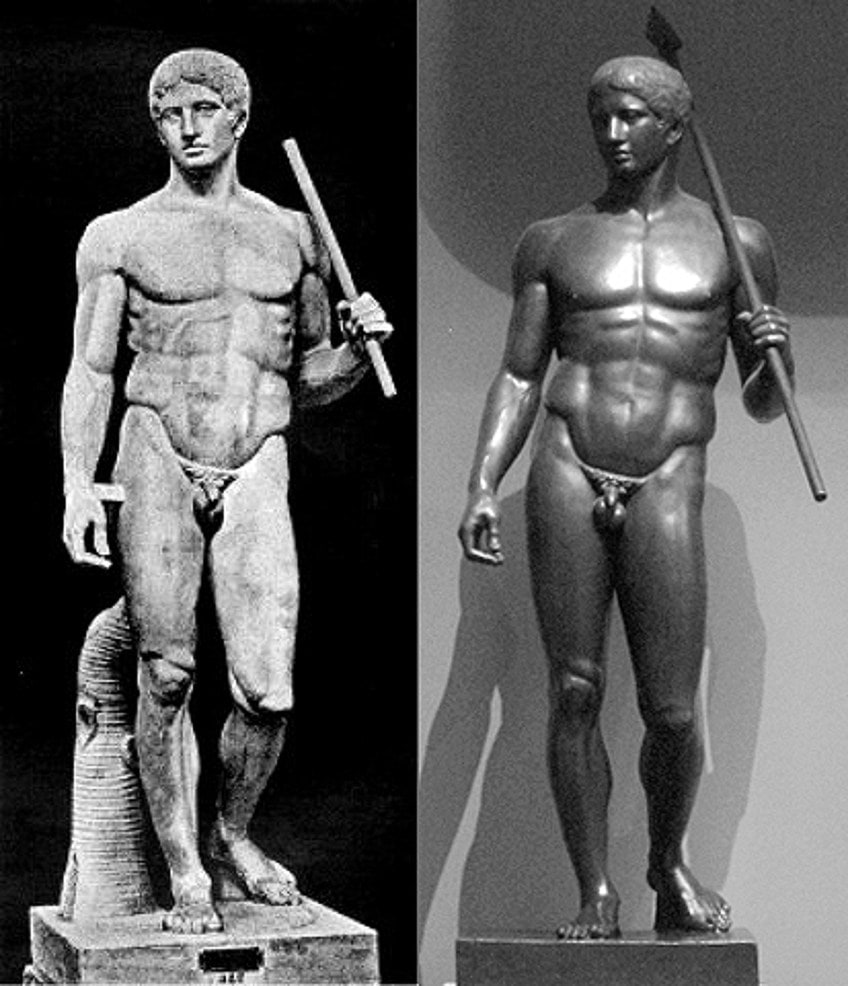 Composite picture of Doryphoros showing the differences between the bronze (right) and marble (left) versions;User:Tetraktys, Public domain, via Wikimedia Commons
Composite picture of Doryphoros showing the differences between the bronze (right) and marble (left) versions;User:Tetraktys, Public domain, via Wikimedia Commons
Polykleitos' canonic measurements of the masculine trunk entrenched in Archaic and Classical periods in the musculus cuirass, as typified by the Augustus of Prima Porta, who wore formal ceremonial armor sculpted in summit over an idealized version of muscular body purportedly fashioned on the Doryphoros sculpture. The emperor's legs are placed in a similar way as the Spear Bearer sculpture'southward posture in the same prototype. Yet some other example of the Spear Bearer Doryphoros' result on sculptures much later than its inception may be seen in David by Michelangelo.
The contrapposto technique, idealized young masculine nakedness, and general antiquity all accept overtones in the Doryphoros sculpture. In that location is indeed a likelihood, though, that the David was constructed with the broader aesthetic contrapposto proportions that Polykleitos popularized as a consequence of his works in view, as evidenced in the referenced Prima Porta statue or the monument of the Apollo Belvedere.
And that concludes our exploration of the Spear Bearer Doryphoros. The Greek sculpture is world-renowned and portrays a well-built warrior. It is regarded as an important instance of Classical Greek realism due to its natural stance. Although the original has been lost to fourth dimension, there are luckily many Roman replicas that help give united states of america a articulate picture of what the original looked like.
Frequently Asked Questions
When was the Spear Bearer Created?
The famous Greek sculpture was made around 440 BCE. Information technology was created past Polykleitos and was a physical representation of his treatise. Today in that location are Roman copies that be of the original. The original was said to be made from statuary.
Why was Doryphoros, or Spear Bearer, Famous Throughout the Ancient World?
Polykleitos, as a contemplative theorist, was intrigued by the algebraic bug posed by the human shape. The Canon is an essay he wrote on the topic of homo dimensions. Polykleitos created the Doryphoros as a demonstration of his treatise'due south views on symmetry between human actual parts. His analytical method resulted in a basic yet well-balanced figure that rapidly became a paradigm of the Classical aesthetic. The Doryphoros was widely reproduced, and it is likely that information technology was the one slice of Greek artwork that had the almost effect on Roman and subsequent art.
Why Is the Doryphoros Sculpture So Important?
The Spear Bearer sculpture is ane of the numerous variations of the aforementioned artwork produced under the Roman Empire. The statuary epitome on which these would exist fashioned is no longer bachelor. The Doryphoros, notable for its symmetry and idealized dimensions, is considered every bit 1 of the best-known specimens of Greek sculpture from the 5th -century BCE and a motion-picture show of ideal manhood. He had to accept been created before the eruption of Vesuvius in 79 CE, which buried Pompeii and everyone and everything. Few genuine bronzes exist today, but Roman artists replicated them widely in stone. Polykleitos' initial Doryphoros was armed with a spear that saturday on his left shoulder, and the sculpture could have stood on its own. (For stability, a tree torso or other caryatid was commonly added to rock reproductions.)
Who Was Polykleitos?
Polykleitos was a statuary creative person from the 5th century BCE in ancient Greece. He is regarded equally one of the near meaning sculptures of classical times, likewise the Athenian artists Praxiteles and Myron. Pliny'southward guidebook in things of painting, the quaternary century BCE inventory ascribed to Xenocrates, classified him between Pheidias and Myron. He is well known for the Canon of Polykleitos, a historical work (a standard of torso shape) that lays along his mathematical foundation for an idealized version of masculine body type.
What Did the Spear Bearer Exemplify?
The Spear Bearer sculpture exemplifies the new method of representing the homo effigy in Greek art during the High Classical Period. The arcadian male person was increasingly emphasized past artists, who showed him in gallant nudity with a youthful, muscular figure that was lifelike in muscle and opinion. The idealist of the Classical style distinguishes it; faces are generalized with no expression or unique traits, while proportions are sleek, strong, and proportioned. Classical statues feature a feeling of mobility, as opposed to Primitive kouros, which stood rigid in an artificial stance fatigued from Egyptian figures. This is washed using a position known equally contrapposto. The Doryphoros stands in this position, with 1 straight leg supporting the weight and the other bending and resting. The forearms, one of which is extended while the other hangs loosely by the side, balancing the legs. The movement, strain, and changing weight all contribute to the illusion of movement.
whitfieldgrals1963.blogspot.com
Source: https://artincontext.org/spear-bearer-doryphoros/
0 Response to "Describe the Most Important Distinction Between High Classical Greek Art and Roman Art"
Post a Comment